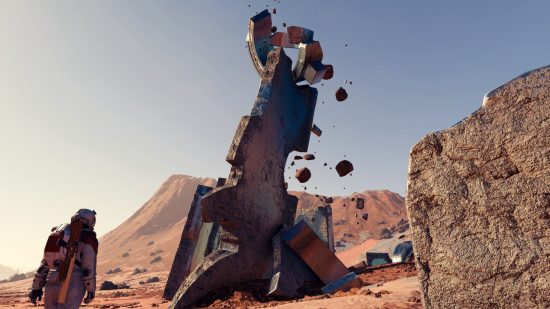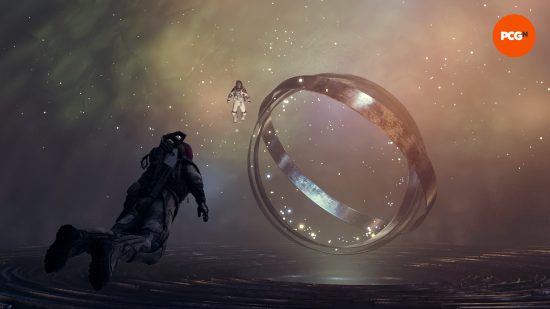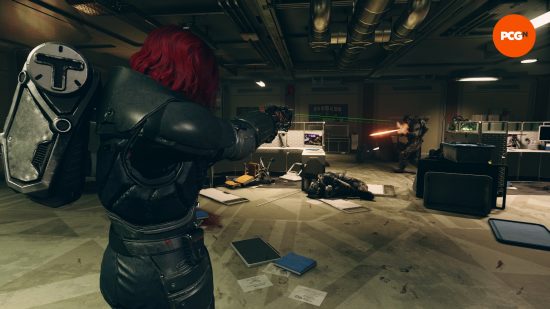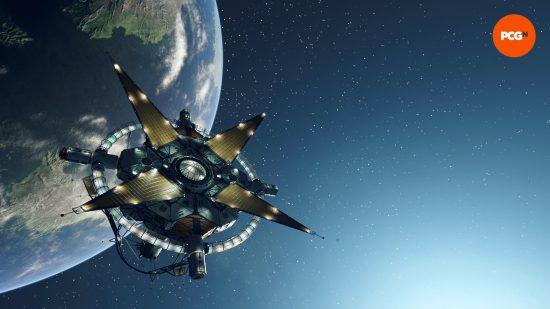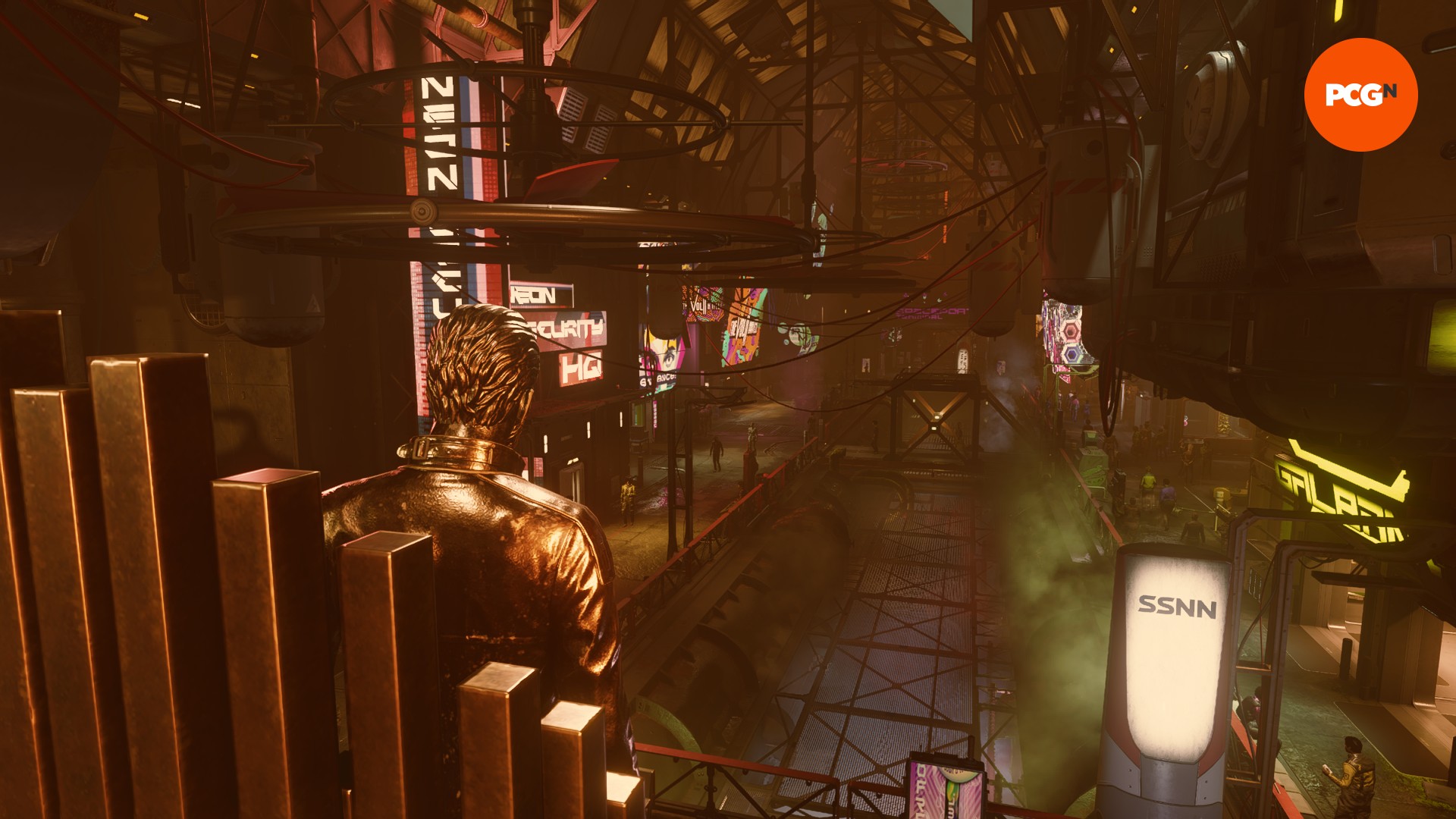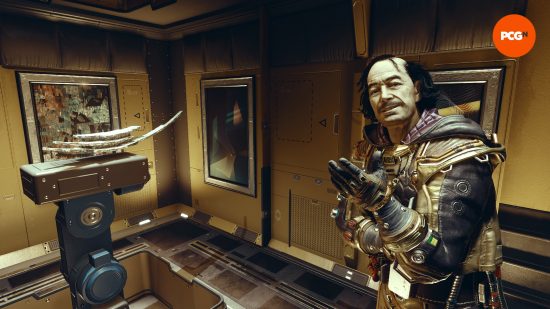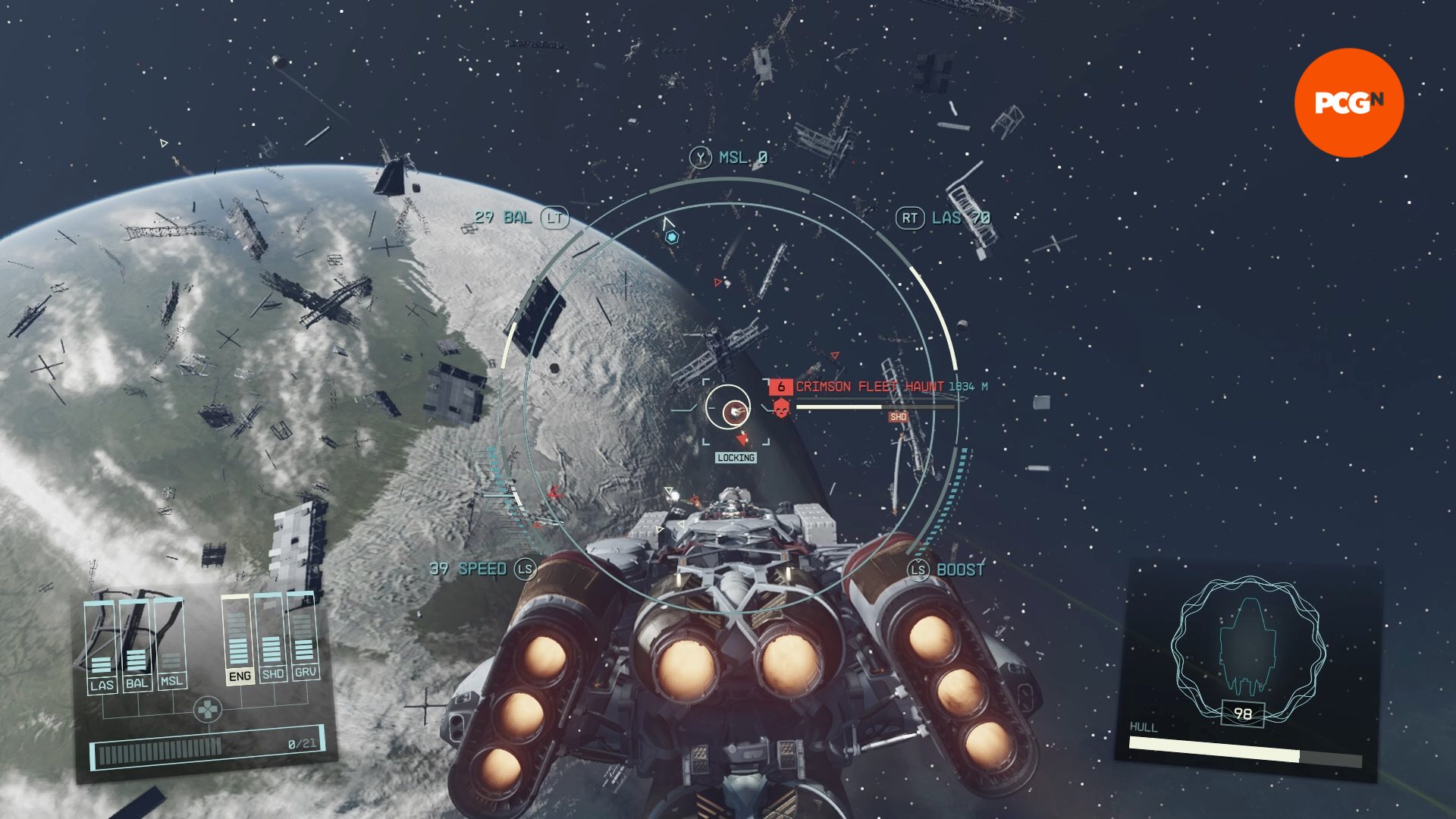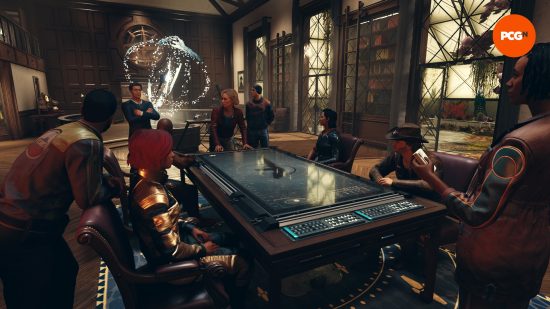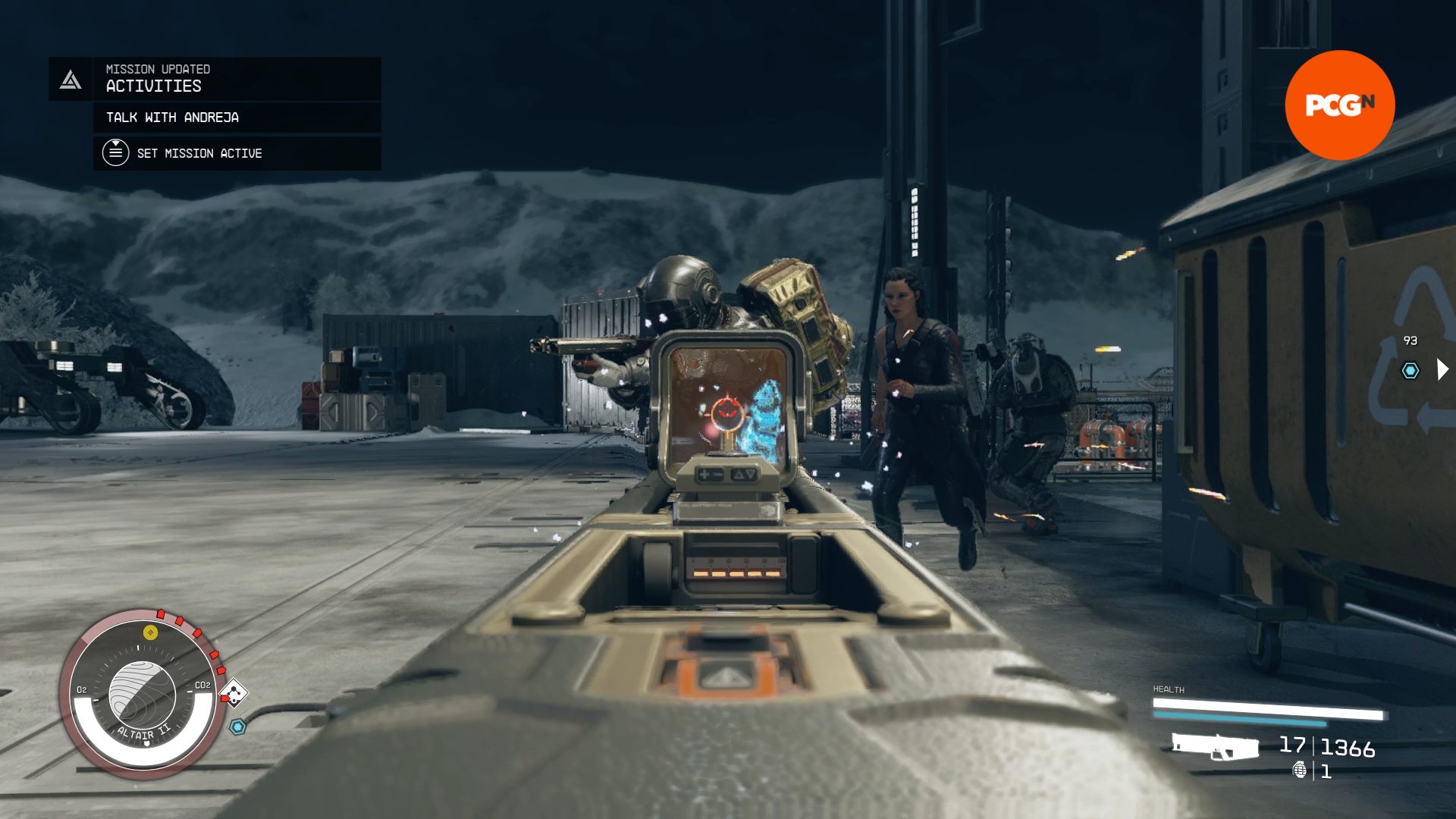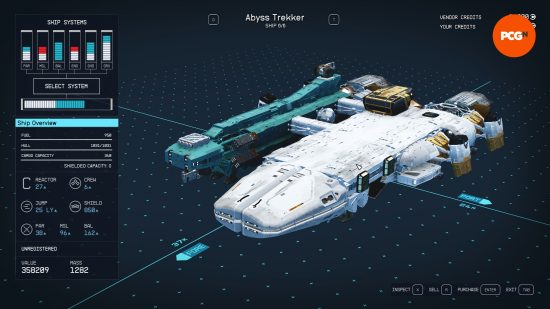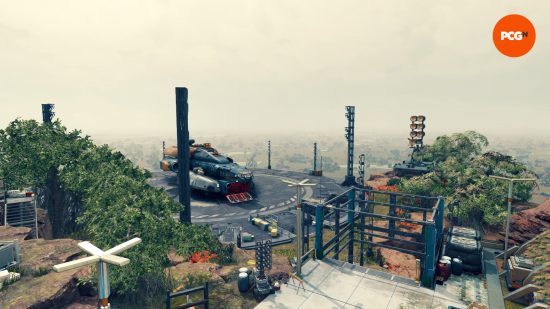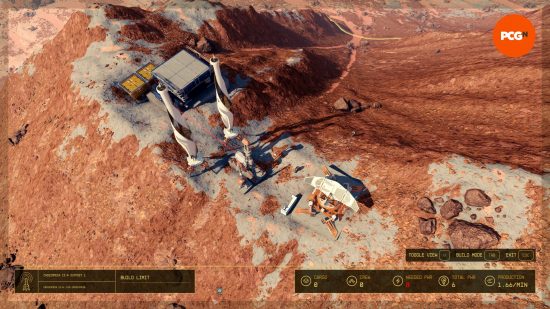Our Verdict
Starfield is a true behemoth of an RPG, and in many ways it's the logical endpoint of Bethesda Game Studios’ well-worn formula. However, its massive scope pushes this formula to the absolute limit and the cracks begin to show, from feature creep to the stop-start nature of its exploration. Dedicated Bethesda fans are sure to get their fill, but this interstellar adventure never leaves the atmosphere.
If you’re looking for the essence of Bethesda Game Studios’ Starfield, look no further than its musical score. A Spielbergian orchestra occasionally gives way to a Roddenberry twinkle, punctuated by Starfield’s own recurring motif: sweeping violins that capture the spirit of utopic hope and grand discovery. This is not too dissimilar from Todd Howard’s pitch on E3’s main stage back in 2021: “an epic, about hope, shared humanity, and answering our greatest mystery.” But does Starfield achieve what it sets out to do? Our comprehensive Starfield review takes you across the Settled Systems to bring you an answer to that question, and includes everything but the interstellar kitchen sink. Well, maybe that, too.
Starfield is a true behemoth of an RPG, and in many ways it’s the logical endpoint of a formula Bethesda Game Studios has been tweaking and fine-tuning for decades, across classics like Morrowind and Fallout 3. The promise of its ‘Skyrim in space’ concept, paired with the space game being the beloved studio’s first new IP in over 20 years, has granted Starfield an instant position among the most anticipated and discussed releases in years. So, 60 hours into this landmark game, and with the campaign done and dusted, how does Bethesda’s first interstellar adventure – and successor to some of the finest RPGs of all time – stack up?
After a close encounter with a mysterious Artifact in the mines of a remote moon at the start of the game, I’m thrust into Starfield’s character creator. I choose from a selection of presets that serve as my biometric ID, which I can then curate to my preference. I’m disappointed to discover that Bethesda has opted for a meager selection of nine skin tones, and the textured hair on offer is both limited and fairly underwhelming. Additionally, while I can opt for gender-neutral pronouns, the inclusion of a neopronoun or two would’ve been the perfect opportunity for Bethesda to lean into Starfield’s vision of a utopian and inclusive future within the intimate space of character creation. Regardless, I spend an inordinate amount of time designing a pink-haired e-girl before outfitting her with Starfield traits that befit her character: an empathetic nature that causes me to take a buff or debuff depending on whether I meet the approval of my companions, as well as doting parents who expect me to pay the rent for their high-rise New Atlantean apartment.
Traits are a nice character touch, but Starfield backgrounds are the meat of my character, and inform my starting skills. I opt for the Sculptor, and I’m delighted at just how many NPCs are quick to comment on how idiosyncratic it is. However, my decision to assume the role of a wide-eyed, sheltered kid stepping out from under her parent’s shadow feels incongruous once I begin to engage in close-quarters combat without so much as batting an eyelid. Perhaps this would be less jarring if I’d chosen a battle-hardened and bloodthirsty background – but given that my profession as a civilian miner is baked into the opening hours of Starfield’s story, I can’t imagine it would help. Even my robot pal VASCO is quick to point out that I’ve undergone “considerable physical and emotional trauma,” an evaluation that’s never alluded to again. Later, space cowboy companion Sam Coe remarks that smugglers are just “people down on their luck, so maybe a little live and let live” after we’ve both massacred an entire encampment of (you guessed it) smugglers. I watch lone wolf Andreja kill a man in front of me during our first meeting; later on, she carefully attempts to explain away her actions after witnessing me clear out a gang of Spacers without batting an eye. To say that Starfield has a fraught relationship with violence would be an understatement.
On that note, my first brush with combat in the Settled Systems is frankly underwhelming. Enemies are veritable bullet sponges, and I find myself consciously battling against weapon sway and kickback while aiming down sights. However, this less-than-stellar first impression fades from memory as I begin to discover weapon modifiers at higher rarities. Starfield weapon mods also minimize the built-in drawbacks of each weapon, though they do require a serious investment of skills and materials if I’m looking to craft them myself. As for the Starfield guns and weapons themselves, there’s a decent selection on offer, from traditional ‘old-fashioned’ artillery to futuristic energy weapons that look like they’re straight out of the Apple store. However, Starfield’s bid for realism means that there’s a distinct lack of silly armaments at my disposal. The Settled Systems are vast, so perhaps a space pirate cannon or sci-fi junk launcher exists on some remote planet somewhere – but if they do, I never encounter them.
Starfield’s combat never loses the weightlessness inherent to any Bethesda RPG, but given that most of these encounters occur in low-gravity environments, it feels substantially more appropriate than it does in Skyrim or Fallout. Starfield’s boostpack is as ubiquitous in combat as it is in exploration; not only can you use it to reposition yourself in a pinch, but you can also take the enemy by surprise and unleash a hail of bullets directly overhead. Historically, Bethesda has never been widely praised for its combat systems. There’s an element of polish here that’s a decisive step forward for the studio, but Starfield still falls markedly short of dedicated shooters, and I often find myself reaching for a grenade just to speed things up.
Once I get my taste for the blood and experience points of the unscrupulous rascals of the Settled Systems, I begin to level up and acquire more Starfield skills. While there’s an abundance of choice here, I often feel pigeonholed into taking specific skills in order to remedy some issue that’s hampering my enjoyment. I can’t access the aforementioned boostpack without sinking a point into Boost Pack Training, and the mechanical nuance of ship combat can only be unlocked via the Tech tree. Equally, making decent use of crafting tables and Starfield research projects in pursuit of equipment mods is a no-go until I invest enough points into the Science tree. Amid all my efforts to simply experience the full scale of Starfield’s systems, skills that grant percentage bonuses scarcely get a look in.
As a staunch fan of Oblivion’s mercurial mood wheel, I was looking forward to foregoing combat by tucking into Starfield’s shiny new persuasion system. Unfortunately, it leaves me entirely cold. While I’m no longer beholden to a flat-rate stat check as in Fallout, I’m instead treated to a series of probability checks attached to lines of dialogue. On the face of it, this system appears to take a holistic approach to persuasion, encouraging you to match the tone and energy of your conversational partner to reach a favorable outcome. However, this approach is undercut entirely by its RNG, which often applies greater weight to dialogue that would realistically harm my chances of winning someone over. I repeatedly reload these conversations, and get wildly different results each time. What’s more, I often succeed at several rounds of dialogue, then failing at the last hurdle and transitioning immediately into combat, which feels somewhat counterintuitive. Shouldn’t I have more of a chance to navigate a conversational pitfall if I’ve already begun to win my adversary over? Not so, according to Starfield’s persuasion system. I’ll take my gunfight and I’ll like it.
On the whole, Starfield’s main quest largely serves as an anchor for exploration rather than a groundbreaking feat of storytelling in its own right. There are a few seismic narrative beats on this main path, but they’re drowned out by a single routine task. Instead of collecting Dragon Shouts or closing Oblivion Gates, a gaggle of pseudo-Masonic space explorers entrusts me with tracking down Artifacts. Each one of these mysterious MacGuffins grants me a vision: a kaleidoscope of sound and light that feels like a throwback to the Prothean visions of Mass Effect way back in 2007, though I’m inclined to give Starfield a pass considering the MacGuffin trope’s enduring presence in the sci-fi landscape. In theory, my Artifact search consists of hopping across different star systems to reach the source of a strange anomaly. In practice, I can often be found doing anything else.
In my defense, there’s no end to the distractions that lead me away from Starfield’s main storyline. Shortly after making my presence known in the wider universe, I am inundated with Starfield missions and side quests galore. A snatch of conversation may generate an activity in my quest log, prompting me to investigate a particular person or place. That said, I’m dismayed at the number of side quests I encounter that amount to little more than running errands for overworked middle managers. However, it only takes a few instances of playing go-between or collecting an arbitrary number of resources before I come to an obvious realization. The Settled Systems are large enough that I can’t be penned into one corner of the universe; if I’m not compelled by a certain side quest or planet, an objective more to my liking is a mere grav jump away. Rather than allowing Starfield to pull me from pillar to post, I curb the impulse to pursue every task that comes my way, and I have a markedly more enjoyable time as a result. It also offers an excellent opportunity for good old-fashioned role-playing. While I could become embroiled in a seedy underground drug smuggling ring, it goes against my character’s nature, and so I politely decline.
In true Bethesda fashion, there are a handful of side quests that are absolute bangers. Some clear standouts involve negotiating colonial treaties between a holiday resort and a generation colony ship, and solving a Star Trek trolley problem by hopping between realities in a science experiment gone wrong. However, such quests are few and far between, and I take a dim view of low-value quests in single-player RPGs. My tactic of pretending that these offerings don’t exist is the greatest indictment of Starfield’s apparent lack of respect for my time, and comes with an unfortunate side-effect: I occasionally stumble upon side quests with built-in tutorials for minor mechanics after hours upon hours of playtime. Equally, while there are certain quests that demand a choice be made, I’m rarely forced to reconcile with the consequences of my actions. Once I move on to the next star system, it scarcely seems to matter.
The Settled Systems are clearly meant to serve as an interplanetary melting pot, but the diversity of faces and accents coalesce into one homogenous and indistinct culture. I remark upon one NPC’s French accent and she imparts a brief anecdote about her ancestry on Earth rather than the planet, place, or culture that’s taken root among the stars. The major Starfield cities are a welcome attempt at diversification – the cyberpunk wealth disparity and drug trade of Neon City stand in stark contrast to the frontier boardwalks of Akila City – but these choices only extend as far as pulp genre aesthetics and expectations.
However, I vastly prefer Starfield’s highly curated and densely packed cities over the emptiness of procedurally generated planets. When I visit Neon City, I can take a wander down to the docks and work a shift on the assembly lines. I can rent one of the extortionate hotel rooms that are themselves a response to the tourist trade that’s sprung up around the city’s staple drug. These are also the spaces where the Settled Systems’ bureaucratic machinations are at their most granular. A brief conversation with a security guard outlines the divisions of local and Starfield faction security, and I’ve barely set foot in Cydonia before I become embroiled in a labor dispute over paperwork and supply chains.
Unfortunately, Starfield’s cultural porridge extends to its religions. While Bethesda has clarified that real-world religions have endured across Starfield’s timeline, I never encounter them on my travels. Instead, the Settled Systems are split into two distinct belief systems: the Sanctum Universum, a monotheist religion that marries pseudo-Christian beliefs with space exploration, and The Enlightened, a somewhat charged title for what amounts to well-meaning atheism. Between these binary opposites lies House Va’ruun, a nomadic cult of religious zealots that believe in the existence of a Jormugandresque Great Serpent predicted to consume the universe. It’s by far the most intriguing of Starfield’s religions, but it’s hardly pushing the theological boat out.
No matter their race or creed, Bethesda has endeavored to imbue its NPCs with more complex facial and body animations, but these minor improvements still leave characters standing around awkwardly orating at me. Of course, this is Bethesda’s signature style of dialogue delivery, but it’s hard to reconcile when compared to the likes of Baldur’s Gate 3’s extensive mo-cap, which does as much for dialogue delivery as the lines themselves. In Starfield, facial expressions are either wholly restrained or uncannily off-putting. In one instance, I compliment Sam’s parenting, and he treats me to a smile that feels like it would be more at home on a Stepford wife. Our conversation moves swiftly on.
The majority of available Starfield companions hail from Constellation’s ranks, though I do encounter a few others that I eventually assign to outposts. Some companions are more fleshed out than others, and I’m actively encouraged to care about the likes of Barrett and Sarah over others. The ones who tag along with me react to situations as they unfold, and in some cases can even speak up on my behalf. A space pirate demands a hefty ransom, and Sarah interjects to offer up Constellation’s own funds rather than my own. However, as I decide on who to bring along with me for the long haul, I desperately wish that Constellation had a recruitable space dog among its ranks. Listen, I’m not ruling out the existence of a space dog. Perhaps there is one and I didn’t find it. But if there isn’t, we owe it to both Fallout’s Dogmeat and the Soviet Union’s Laika to change that with Starfield mods.
Broadly speaking, my selection of eligible suitors is fine. They’re likable, and while we share a generic camaraderie, my interactions with them never develop into full-blown chemistry. I’m somewhat relieved that they won’t hop into bed at the drop of a hat; instead many of them need time before they’re emotionally ready for a Starfield romance with me. However, I vow to pursue Andreja from the moment we meet, and yet I encounter only one opportunity to flirt with her over the course of my entire playthrough. It’s not for want of trying; once I’ve exhausted the gamut of personal questions, my available interactions with her largely consist of item trading or outright dismissal. This leaves my relationship with Andreja genial but sterile – though she does offer up her tragic backstory after an arbitrary amount of time spent together. Of course, I can settle for platonic companionship over a steamy space romance, but the fatal flaw of Starfield’s companions is their distinct lack of growth. They are static figures in an ever-changing landscape, and while they respond and react to situations, they never materially change in themselves.
Once I enter the Frontier’s cockpit, I’m confronted with a diegetic interface of tactile switches to manage the performance of my weapons, shields, and engines. Ship movement controls are intuitive, though I find them to be fiendishly difficult at times. These dogfights are undoubtedly cinematic in nature, but any strategic approach I take generally devolves into wheeling around and desperately trying to find a ship at which to take aim, and while also avoiding the hail of laser fire and missiles on all sides. I can count the number of times I died in Starfield on one hand, and all of those deaths occurred in the cockpit.
In an effort to give myself a little more survivability, I retreat to Starfield’s ship builder. There’s an extensive amount of customization on offer, and it’s thankfully nowhere near as complex as it seems at a glance – as long as you’ve got the fundamental components, you’re free to construct the cosmetic details of your ship in whatever way you see fit. I also appreciate the in-universe hardware brands competing for my custom that keep me connected to Starfield’s wider universe. Nova Galactic offers a catalog of sleek, matte white Jobsian products, while Deimos caters to the classic industrial sci-fi fan. A faithful recreation of Red Dwarf is just within my grasp.
The actual process of upgrading my Starfield ship is not unlike upgrading a PC. My extensive cargo hold is too heavy, so I buy bigger engines to compensate, only to discover my budget reactor isn’t strong enough to power them fully. So, off I go to upgrade my reactor. Of course, I don’t have to upgrade my cargo hold, but the sheer number of resource-dependent systems in Starfield pretty much demands it. What’s more, this race to the top of cutting-edge components eventually plateaus, and I’m forced to take another skill to build bigger ships to handle late-game encounters with fleets of hostile spacecraft. Alternatively, I can buy ships wholesale or steal them for myself. The latter doesn’t always require space piracy and bloodshed; at one point, I accidentally wander into the landing bay of an abandoned ship on a remote outpost, break my way inside, then take off to register it as my own before I can be caught.
I can skip a few steps in the lengthy process of traveling from one planet to another by performing a grav jump directly from my map. The liminal space of a planet’s orbit contains the quietly impactful encounters of space travel. It’s here that I meet an elderly nomad known only as Grandma, who regales me with tales of her travels and her grandchildren. I also compliment a soft-voiced Scotsman singing space shanties in the scant seconds before he grav jumps away. However, this orbital stall also draws attention to how compartmentalized Starfield’s map really is, and no matter the shortcuts I take, the process to get from one location to another involves jumping through a series of loading screens that are compounded by yet more loading screens once I do finally touch down.
Again, Starfield has so much to offer that I have the freedom to choose my approach to space exploration. My first few grav jumps are imbued with the excitement of picking a planet at random for a quick day trip, though my spirit of adventure fades once I realize how likely it is that my chosen destination will amount to little more than a barren rock. Instead, the bulk of my exploration coincides with side quests, where I allow myself to be led off the beaten path towards points of interest. However, even these are frequently underwhelming, and my cross-country treks often terminate in a geological feature – inarguably pretty, but not terribly rewarding – or alternatively, a nondescript facility full of enemies and miscellaneous loot. Starfield takes a non-invasive approach to surveying planets; I’m not actively encouraged to rip up plants and gun down the local wildlife, but scanning everything in sight quickly becomes monotonous. Instead of going out of my way to gather data, I use my scanner to mine resources to fill time on the trek from one map marker to the next. I reach the end of my playthrough with very little survey data under my belt, and I can’t bring myself to care.
Space abhors a vacuum, and humanity has endeavored to fill the Settled Systems with so much junk that it’s often difficult to parse leftover alien stir fry from rare crafting materials at a glance. Eventually, I begin to acclimatize to the constant visual noise with the help of vibrant containers full of valuable items standing out from all the clutter. In order to account for Starfield’s greater scope, this latest iteration of Bethesda’s encumberment system is its kindest yet. Instead of restricting me to a painful crawl the second I tick over my weight allowance, I’m merely forced to manage my O2 levels carefully so I don’t incur a negative status effect. This change is a godsend, allowing me to continue to clear out underground facilities and complete quests uninterrupted. However, as a self-professed loot goblin, I spend an inordinate amount of time over the course of my playthrough stuck in the mire of inventory management, juggling resources between my cargo hold and my companions, before inevitably losing track of my equipment along the way. “Is it really necessary for you to drag around all this gear?” Sarah Morgan snipes at me for the umpteenth time. Why yes, Sarah. Yes it is.
Of course, the main benefits of space exploration are the various resources and crafting materials I can harvest along the way. It’s possible to automate collection via Starfield outposts, but I often run into a recurring problem that kills my love of them in the cradle. After constructing my outpost, I’m informed that I have insufficient raw materials to build a resource extractor. On the face of it, this is easily remedied – all I need to do is find a planet with that resource and build a second outpost to extract it, right? Wrong. This extractor requires a different raw material, forcing me to traverse the landscape on foot for any material nodes on the surface. Outposts are prime real estate for fans of management games, and I get a taste of it once I develop one to the point where I can establish supply lines to my ship. However, the whole process is such an arduous experience that I never feel the inclination to repeat it.
The sheer number of features and mechanical systems packed into Starfield is truly staggering, but Bethesda’s reputation for launching massive worlds riddled with game-breaking bugs might leave you nervous about how these moving parts interact. I’m pleased to report that Starfield bucks the trend. The only exception is a strange propensity for generating an autosave seconds before my ship explodes, like a terrible interstellar Groundhog Day – an issue that’s easily resolved by loading an earlier save. In terms of framerate, my time with Starfield is smooth sailing, and I only encounter the occasional drop in Neon City’s nightclub, on a dancefloor crammed with people. That said, for better or for worse, the quintessential Bethesda jank is also present and correct. Wayward NPCs occasionally drift into frame during vital conversations, and I am forced to spend a long-awaited heart-to-heart with a standoffish companion while staring at the back of her head. While this might be written off as prime old-school meme potential, my largest grievance lies in how frequently I’m forced to parse multiple barks at once, as NPCs trip over each other to dispense information.
There’s a running theme that the Settled Systems lack humor, but I often find Starfield inadvertently hilarious. The procedure to change your appearance has a No Disfigurement Guarantee. Barrett solemnly asks me if I have a moment to speak with him, only to hand me a grilled cheese sandwich and walk away. I throw an impact grenade at a platoon of Spacers on a low-gravity moon and take cover as their bodies are propelled into the atmosphere. “Owie! Woo! I’m fine!” Barrett reassures me after he gets caught in a landmine explosion, and then rounds the corner on fire. I ask VASCO if he knows any human jokes. “I am looking at one,” he quips in his signature monotone. For all that Bethesda’s dedication to hard sci-fi and strict minimalism engenders a sense of the studio taking its world too seriously, there is still a glimmer of the classic Bethesda charm to be found here.
To say that Starfield is a behemoth is an understatement. Bethesda RPGs are a subgenre in themselves, and the studio has clearly gone to great pains to push its acclaimed formula to the absolute limit. However, I can’t help but feel that the formula in question is struggling to keep up within the wider context of the genre, which is being pushed in bold new directions by the likes of Larian Studios and CD Projekt Red. While Bethesda has clearly outdone itself with Starfield, that can’t be said of everyone else, and there’s enough feature creep to leave Starfield a jack of all mechanics but a master of none. If you’ve been itching to get your hands on an all-new Bethesda experience, there’s no question you’ll gain a lot of enjoyment out of Starfield. However, there’s very little new ground being broken here, and as I forge my own path across the Settled Systems I’m conscious of the groundwork laid by the likes of Mass Effect and No Man’s Sky. Throw me out of an airlock if you wish – I like Starfield, but I don’t love it.
